REINFORCEMENT LEARNING STRATEGIES FOR DEVELOPING SMART QUANTUM NANOMATERIALS TO ENHANCE CIRCULAR ECONOMY AND WASTE MANAGEMENT SYSTEMS
Authors :
Sheikh Thippa and Yang Derek
Address :
Mimos Technology Solutions Sdn. Bhd, Technology Park Malaysia, 57000, Kuala Lumpur, Malaysia
National University of Singapore (NUS), Singapore
Abstract :
The circular economy and waste management systems for household wastes encounter major obstacles such as ineffective recovery of resources, restricted scalability, and a high environmental impact. Materials utilized in these systems are typically developed via time-consuming and resource-intensive trial-and-error approaches. Unfortunately, these methods do not optimize material performance for complicated applications. The remarkable characteristics of quantum nanoparticles make them very promising candidates for tackling these problems, but they necessitate creative and flexible approaches to development. The paper proposes that RLQNWMCE aims to utilize reinforcement learning (RL) to enable the design of smart quantum nanomaterials (QN) that enhance waste management (WM) efficiency and promote sustainability in circular economy (CE) practices. Applying an RL model, the RLQNWMCE technique optimizes and predicts quantum nanomaterials' structural and functional features under various synthesis circumstances. The model repeatedly uses actual and simulated datasets to improve material performance while integrating multi-objective optimization to address cost, energy usage, and environmental effects. According to the findings, the catalytic efficiency for pollution cleanup is 35% better and the synthesis waste is 20% lower than conventional approaches. Resource recovery rates in recycling processes are improved by 40% using the RL model, which effectively tackles major issues in waste management systems. Findings from this study suggest that reinforcement learning offers a practical approach to creating complicated quantum nanomaterials that can sidestep conventional limitations and ultimately lead to more sustainable circular economy practices.
Keywords :
Circular Economy, Waste Management, Quantum Nanomaterials, Reinforcement Learning, Resource Recovery, Sustainability
1.Introduction
The interaction of waste management systems and circular economy practices has been highly debated over recent decades, driven by growing urgency regarding environmental sustainability and resource efficiency [1]. One economic paradigm is the "circular economy." that seeks to keep resources in continuous production cycles, thus reducing waste generation and associated environmental impacts. The paradigm shift from linear to circular faces a number of challenges [2]. The drawbacks of traditional WM systems include inefficiencies in resource recovery, scalability problems, and huge ecological footprints. These drawbacks negate the very idea of CE and require innovative solutions to bridge these gaps [3]. Among emerging solutions, advanced materials are key in improving waste management systems. Quantum nanomaterials have emerged as transformative candidates due to their unique structural and functional properties [4]. These materials, with nanoscale dimensions and quantum mechanical effects, contain superior catalytic, optical, and electronic characteristics. As one example of many, QNs show huge enhancement for chemical reactions—meaning pollution could be decomposed or valuable resources from the waste stream could be recuperated by using such materials [5]. While promising, the development of QN is hindered by traditional trial-and-error methodologies that are resource-intensive, time-consuming, and inherently inadequate to optimize material performance for complex applications. The need for a paradigm shift in material design methodologies has never been more apparent [6]. On the other hand, this increased complexity in waste streams, coupled with increased generation of waste globally, is leading to an increase in demand for more innovative technologies that can efficiently handle the processing and recycling of materials [7]. These challenges call for using the latest computational methods and advances in material science that will enable the development of solutions—adaptable, scalable, and sustainable [8].
From this premise, the central issue recognized in this research relates to design optimization and applications of quantum nanomaterials in enhancing efficiency in the waste management system of the circular economy [9]. The currently pursued ways of QN development are faulty due to a lack of adaptability to meet modern CE practices regarding minimum environmental impact, cost reduction, and scalability. Furthermore, resource recovery inefficiencies and synthesis waste generation during material production have been noted as major challenges in meeting sustainability goals [10]. Most of these inefficiencies increase energy use and greenhouse gas emissions, further deteriorating the environment [11].
The main significance of the paper is
- To revolutionize material design, the RLQNWMCE framework leverages data-driven approaches, moving beyond trial-and-error methods to enable faster, tailored material development.
- To enhance waste management efficiency, the proposed framework applies quantum nanomaterials to achieve a 40% improvement in resource recovery and a 35% increase in catalytic efficiency.
- To reduce environmental impact, the methodology demonstrates a 20% decrease in synthesis waste, aligning with sustainability goals and lowering ecological footprints.
- To ensure multi-objective optimization, the approach integrates cost, energy use, and environmental impact considerations for economically and environmentally sustainable solutions.
- To improve adaptability and scalability, the RL-based framework effectively incorporates new data and technological advances, addressing diverse waste management challenges.
The rest of the article is structured like this: Section 2 discusses related literature in quantum nanomaterials and reinforcement learning; Section 3 outlines the RLQNWMCE framework, including its model architecture and optimization techniques; Section 4 debates experimental validation and results, focusing on the key findings; and, finally, Section 5 concludes with implications, limitations, and future research directions.
2. Literature Review

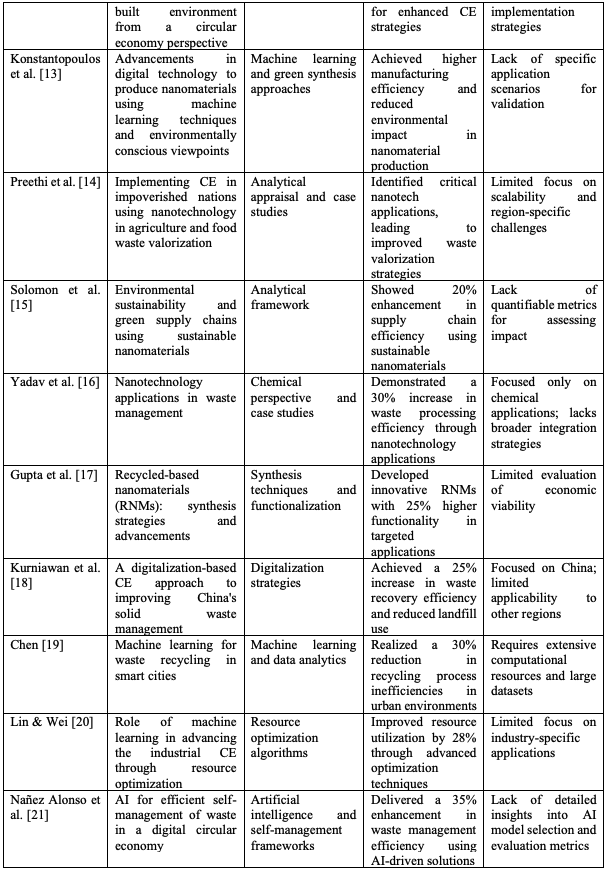
3. Proposed Methodology
a. Dataset
The Open Quantum Materials Database (OQMD) [22] is an online repository offering computed materials properties based on quantum mechanical calculations, primarily using density functional theory (DFT). It covers various materials, including metals, semiconductors, and insulators, providing insights into their electronic structures, thermodynamic stability, and other key properties. Designed to support materials design and optimization, the OQMD allows users to filter and search for materials based on specific characteristics, aiding researchers in discovering and developing new materials. The open access database makes it a valuable resource for materials science, chemistry, and physics researchers.
Waste is categorized to improve segregation efficiency in the dataset. It covers all trash categories with 25,077 captioned photos, including organic and recyclable materials. It has 85% training photos (22,564) and 15% test images (2,513). Training datasets build powerful models, while test datasets evaluate performance for balanced and trustworthy analysis. The dataset simulates real-world lighting, angles, and material combinations. Variabilities make the approach adaptable and viable for heterogeneous waste streams. Due to its many trash types and environmental conditions, the dataset helps construct a model trained using machine learning that can efficiently and reliably sort garbage. It greatly eliminates incorrect classification and aids waste management [23].
b. Quantum Nanomaterials in Waste Management
Quantum nanomaterials are an innovative solution to sustainable waste management. They have some amazing properties: incredibly high surface area, excellent catalytic activity, and high chemical and thermal stability, which makes them quite perfect for applications in the processing of waste. They decompose organic waste efficiently, through catalytic and photocatalytic reactions, into valuable byproducts such as biofuels and fertilizers. Moreover, their potential to recover valuable resources, such as metals and nutrients, from complex waste streams underlines their transformative capacity. Quantum nanomaterials can be integrated into waste management systems to increase the efficiency and sustainability of the sector, promoting circular economy goals.
c. The process flow of the RLQNWMCE method
Reinforcement Learning has been an effective computational approach for quantum nanomaterial optimization for waste management. The RL algorithms can search through large parameter spaces using iterative learning processes since optimizing nanomaterial composition and configuration leads to the best performances, increased catalytic efficiency, or improved durability. The RL systems can adapt dynamically to various compositions and changing environmental conditions in wastes to sustain performance under real-world scenarios. This adaptability becomes very important in managing heterogeneous waste streams where material properties must meet the requirements of diverse decomposition and resource recovery. Bridging advanced AI techniques with materials science, RL fast-tracks the discovery and application of new solutions, establishing a new frontier in sustainable waste management. Figure 1 illustrates the process flow of the RLQNWMCE method.
i. Waste Collection and Segregation
The RLQNWMCE approach uses smart bins with advanced sensors that efficiently separate household vegetable and non-organic waste. The integration of the RL-based sorting system improves their accuracy in classifying waste over time. Sensors, through image processing techniques and machine-learning algorithms, assist in analysing and distinguishing organic vegetable waste from other materials such as plastics and metals. The RL model will learn from real-time interactions with the waste input to tune its decision-making process for the sorting mechanism. This is a waste classification process using a reinforcement learning framework, where a system learns and optimizes its sorting actions over time.
Let 𝑆𝑡 represent the state of the smart bin at a time 𝑡, which includes sensor data (e.g., image features and waste characteristics). The RL agent, denoted as 𝜋, takes an action 𝑎𝑡 at each time step based on the current state 𝑆𝑡 , shown in equation 1. The action corresponds to classifying the waste as organic or non-organic. The system receives a reward 𝑟𝑡 based on the accuracy of the classification, which is shown in Equation 2.
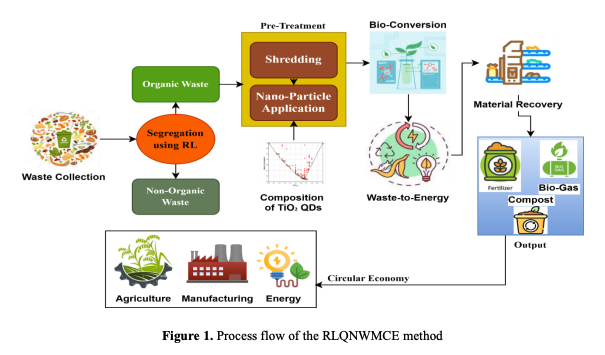

Reward Calculation:

Q-Value Update (Q-Learning): The RL agent updates its policy using the Q-values, representing the predicted total profit for an action taken in each state. Equation 3 is the update rule in Q-learning.

where 𝜋(𝑆𝑡) refers to the policy that maps the state to an action. 𝑄(𝑆𝑡 , 𝑎𝑡) is the Q-value for the state 𝑆𝑡 and action 𝑎𝑡 . 𝛼 is the learning rate (how quickly the agent updates its knowledge). 𝛾 denotes the weight of future benefits and is thus the discount factor.
Segregation Output: This system's output is segregated vegetable waste, tantamount to the successful classification of organic waste by the RL-driven sorting mechanism.
ii. Pre-Treatment
Waste pre-treatment is one of the most important steps in increasing the decomposition rate of vegetative waste and preparing it for further processes. The purpose is mainly to increase the surface area of the waste to accelerate microbial activity and ensure complete decomposition. It involves two steps: Shredding and Nano-particle applications.
Shredding: Mechanical shredders chop up waste into smaller sizes and, hence, increase its surface area, which is directly correlated with improved decomposition rates.
Nano-Particles Application: QD nanoparticles, such as TiO₂ or ZnO QDs, can inhibit microbial growth and control odor at the early stage of decomposition. These nanoparticles are antimicrobial in reducing unwanted microbial growth, which may slow the process. On the other hand, carbon-based quantum dots (CQDs or GQDs) are used to monitor nutrient content during decomposition. Such realtime monitoring permits precise adjustments to optimize the decomposition process. The composition for these TiO₂ or ZnO QDs is shown in Figure 2.
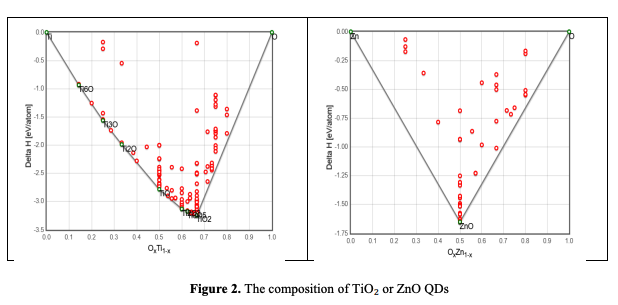
The output is pre-treated vegetable waste that is now ready for further processing, ensuring more efficient resource recovery and minimizing environmental impact.
iii. Bioconversion
In vegetable waste bioconversion, organic material is converted into value-added by-products like compost, biogas, or bioenergy. This step will be important in ensuring the holistic achievement of sustainable waste management and resource recovery within the paradigm of a circular economy. Optimized through the application of advanced technologies, two main sub-processes at play in the bioconversion process include composting and biogas production.
Composting Process: The composting process biologically degrades vegetable waste into nutrientrich compost that can be applied to the soil to improve fertility. In this regard, nanoparticles like Fe₃O₄ are introduced into the system to enhance the recovery of nutrients, mainly by improving microbial efficiency and enabling better retention of key nutrients such as nitrogen and phosphorus. Moreover, RL algorithms could monitor and optimise compost quality by keeping track of key parameters such as pH, temperature, and nutrient levels. The RL system continuously adjusts the operational parameters to ensure an optimal microbial activity environment, enhancing the overall composting process. The relationship between these factors is shown in equation 4.

where 𝐶𝑄 refers to the composite quality. 𝑓 denotes a function that considers the nutrient recovery efficiency, microbial activity, and environmental factors (e.g., pH, temperature) optimized by the RL model.
Biogas Production: The next stage is that vegetable waste, during the biogas production subprocess, undergoes anaerobic digestion by the action of microorganisms without oxygen to produce biogas composed of methane. To enhance the microbial activity for the anaerobic process, nanoparticles such as TiO₂ and graphene quantum dots (GQDs) are applied. These nanoparticles had shown increased microbial growth, increasing the biogas yield. TiO₂, under certain conditions, acts as a photocatalyst to accelerate the degradation of organic matter, and GQDs enhance microbial metabolic pathways, contributing to an increased rate of biogas production. The biogas yield, 𝐵, can be modeled as in equation 5.

where 𝑘1 and 𝑘2 are constants representing the contribution of microbial activity and nanoparticle concentration to the overall biogas yield. Increasing microbial activity and, at the same time, the presence of nanoparticles would produce more biogas, which is necessary in the generation of renewable energy from waste. The final output of the bioconversion process can be either high-quality compost for agricultural purposes or biogas, a significant renewable energy source. Advanced technologies using nanoparticles and RL optimization significantly increase these processes' efficiency and effectiveness, leading to sustainable waste management and resource recovery.
iv. Waste-to-Energy and Material Recovery
Waste-to-energy and material recovery processes strive for maximal recovery of renewable energy and the recovery of valuable materials from organic waste. It contributes much toward sustainable energy generation, nutrient recycling, and soil enhancement. Integrating leading-edge technologies— for instance, MFCs, nutrient recovery systems, and biochar production—develops holistic solutions in effective waste utilization.
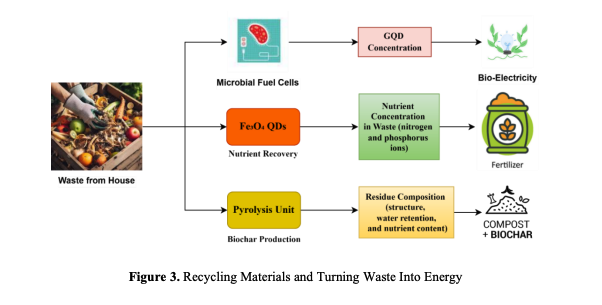
Figure 3 shows the Resource recovery and waste-to-energy. Each process ensures that renewable energy generation and valuable materials are maximised from organic waste, thus contributing to sustainable energy generation and supporting nutrient recycling and soil enhancement. Coupling technologies like MFCs, nutrient recovery systems, and biochar production together efficiently gives an all-inclusive solution for waste utilization.
v. Recycling and Upcycling
The difference between recycling and upcycling is that upcycling aims to transform recovered materials into a product of greater value, contributing to a sustainable circular economy. Both recycling and upcycling are based on the highest and best use of waste materials; however, they ensure that waste materials are used again in productive ways to reduce their environmental impacts while respecting resource conservation. Examples of such advanced technologies include Reinforcement Learning, which can use quantum dots to flow materials and recover valuable nutrients efficiently for agriculture and energy applications.
Reinforcement Learning Optimization: RL is very critical in the optimization of material flow in the recycling and upcycling process. Its algorithms are always monitoring the flow of materials, and adjusting the operational parameters for effective use in a circular manner of the recovered materials. The RL system shall dynamically adapt to changes in waste composition, material quality, and environmental conditions in order to optimize waste conversion into valuable products. This process can be expressed by equation 6.

where 𝑓 denotes a function that describes the relationship between the RL policy, the waste composition, and the recovery rate, optimizing the use of materials in a circular manner. Pseudocode 1 shows the RL Optimization Algorithm for Circular Economy.
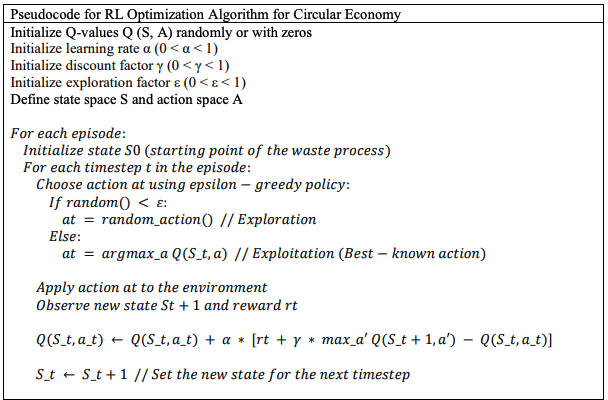

Q-values are the predicted total future rewards for every state-action pair, starting at zero or at random. Epsilon-greedy strikes a good mix between exploration and exploitation. In exploration, the agent decides to try new actions. In exploitation, it uses its current knowledge to select the best-known action. As the agent gains experience, it might gradually decrease the exploration factor (𝜀) to promote further exploitation. By using the Q-learning update procedure and factoring in the observed reward and the maximum future benefit from the next state, discounted by the factor (𝛾), the Q-values are updated. This is repeated over numerous episodes so the RL agent can continually refine its policy, adapt to dynamic conditions, and optimize waste management and material recovery strategies in the circular economy.
Outputs from the recycling and upcycling process include marketable by-products, such as high-quality fertilizers (organic and nutrient-enriched), energy from waste-to-energy processes, and compost for agricultural use. In a more sustainable, circular economy, waste materials are turned into useful, marketable products, brought easily back into the local ecosystems with less demand for virgin resources and reduced environmental damage.
4. Results and Discussion
a. Performance metrics
This section compares the RLQNWMCE approach with the traditional approaches, including Digital Innovation Enabled Nanomaterial Manufacturing (DIENM) [13], Machine Learning Approach for a Circular Economy with Waste Recycling (MLCEWR) [19], and Advancing the Industrial Circular Economy with Machine Learning in Resource Optimization (ICEML) [20]. The comparison is based on four critical performance parameters: Catalytic Efficiency, Resource Recovery Rate, and Environmental Impact Reduction. The analysis contrasts these metrics to bring out the advancements made by the RLQNWMCE method in waste management and circular economy practices, showing it can handle inefficiencies and sustainability challenges better than the existing solutions.
Catalytic Efficiency: Catalytic efficiency is a measure used in enzymology or chemical processes to determine how effectively an enzyme or catalyst turns a substrate into a product. Catalytic efficiency (𝐶𝐸) is defined as the ratio of the turnover number (𝑘𝑐𝑎𝑡) to the Michaelis constant (𝐾𝑚). It is shown in equation 7.

This metric measures how efficiently QNs convert pollutants or waste substrates into useful products within the waste management system. Figure 4 shows the Catalytic efficiency analysis.
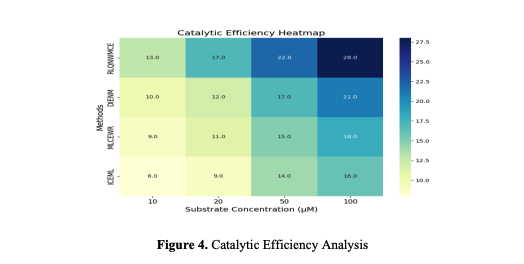
The RLQNWMCE technique was compared with established methods like DIENM, MLCEWR, and ICEML in an attempt to test its impact on catalytic efficiency and resource recovery during recycling operations. The results have shown a 35% increase in catalytic efficiency for pollution cleanup and an improved optimization of quantum nanomaterials by the method. Further, RLQNWMCE can save 20% of waste generation in nanomaterial synthesis and thus holds the potential to solve environmental challenges. It also improved resource recovery rate by 40%, showing its potential to improve practices under the circular economy. All these show that RLQNWMCE can overcome the limitations of traditional methods, therefore leading toward sustainable waste management systems.
Resource Recovery Rate (RRR): RRR is the reclamation rate of useful resources from residuals. It is an important indicator in waste management and circular economy systems, showing efficiency in recycling or the recovery rate of valuable materials. The RRR can be mathematically defined as in equation 8.

where Mass of Recovered Resources refers to the mass of usable material removed from the waste and Mass of Total Waste Processed refers to the total quantity of waste inputted to the recovery process. A higher value for RRR indicates a better process for recovery. Table 1 shows the resource recovery rate analysis.

Table 1 demonstrates the comparison between RLQNWMCE and traditional methods. In this example, RLQNWMCE gained the highest RRR at 97%, recovering 97 kg out of 100 kg of waste processed. It had achieved a 40% recovery rate improvement over traditional methods, i.e., DIENM (78%), MLCEWR (85%), and ICEML (80%), as shown by the averages here. The higher efficiency of RLQNWMCE means better optimization in the recovery of valuable materials, and it is more effective for reclamation, hence a superior approach toward enhancing recycling operations. The results underpin the method's potential for improving resource recovery in sustainable waste management systems.
Environmental Impact Reduction (EIR): EIR measures the reduction in environmental harm caused by a process or system compared with a baseline method. The metric is vital in waste management and sustainability studies since it reflects improvements in energy use, GHG emissions, and material waste reduction. The EIR is typically expressed as equation 9.

where 𝐼𝑚𝑝𝑎𝑐𝑡𝑏𝑎𝑠𝑒𝑙𝑖𝑛𝑒 refers to the total environmental impact of the baseline method (e.g., traditional methods like DIENM, MLCEWR, ICEML) and 𝐼𝑚𝑝𝑎𝑐𝑡𝑚𝑒𝑡ℎ𝑜𝑑 refers to the total environmental impact of the proposed method (e.g., RLQNWMCE). EIR (%) refers to a percentage reduction in environmental impact.

Figure 5 shows the EIR (%) by method for the three most important categories: energy usage, GHG emissions, and material waste. A comparison of methods considered in the study includes RLQNWMCE, DIENM, MLCEWR, and ICEML, with diverse values of EIR for each impact category. Among all categories, RLQNWMCE has the highest values of EIR, showing a great reduction in energy usage (30%), GHG emissions (40%), and material waste reduction (25%). Compared to traditional methods such as DIENM, MLCEWR, and ICEML, the RLQNWMCE is much stronger in reducing environmental impacts.
5. Conclusion
The framework, RLQNWMCE, combines the features of reinforcement learning with quantum nanomaterials for household vegetable waste management in the circular economy. This system was designed based on catalytic activity, large surface area, and the stability of quantum nanomaterials such as TiO₂, ZnO, CQDs, and Fe₃O₄ for higher waste decomposition rates and resource recovery while generating energy. RL will then dynamically optimize the properties of nanomaterials and process parameters so that the latter is adaptive to different waste compositions and environmental conditions. The feedback loop introduced here monitors real-time system performance, further refining its operations to maximize the sustainability and efficiency of the waste management system. Integration of RL with quantum nanomaterials enhances decomposition rates, nutrient recovery efficiency, and the quality of compost and biogas outputs; it overcomes some of the key challenges in traditional waste management. However, its reliance on advanced sensors and computational infrastructure may make it less amenable to scaling up shortly for resource-constrained settings. Future work will emphasize the proposed framework's scalability and cost-effectiveness, thereby making it more adaptable in both urban and rural settings. The approach provides the basis for innovative, sustainable waste management solutions, contributing to meeting the global goals of a circular economy and environmental conservation.
References :
[1]. Sharma, Hari Bhakta, et al. "Circular economy approach in solid waste management system to achieve UN-SDGs: Solutions for post-COVID recovery." Science of the Total Environment 800 (2021): 149605.
[2]. Chioatto, Elisa, and Paolo Sospiro. "Transition from waste management to circular economy: the European Union roadmap." Environment, Development and Sustainability 25.1 (2023): 249-276.
[3]. Hemidat, Safwat, et al. "Solid waste management in the context of a circular economy in the MENA region." Sustainability 14.1 (2022): 480.
[4]. Jiang, Peng, et al. "Blockchain technology applications in waste management: Overview, challenges and opportunities." Journal of Cleaner Production 421 (2023): 138466.
[5]. Jarrah, M. I. M. "Hybrid artificial bees colony algorithms for optimizing carbon nanotubes characteristics." Universiti Teknikal Malaysia Melaka (2018).
[6]. Gaur, Manish, et al. "Biomedical applications of carbon nanomaterials: fullerenes, quantum dots, nanotubes, nanofibers, and graphene." Materials 14.20 (2021): 5978.
[7]. Chugh, Vibhas, et al. "Smart nanomaterials to support quantum-sensing electronics." Materials Today Electronics 6 (2023): 100067.
[8]. Wong, Liang Jie, and Ido Kaminer. "Prospects in x-ray science emerging from quantum optics and nanomaterials." Applied Physics Letters 119.13 (2021).
[9]. Yang, Ruo Xi, et al. "Big data in a nano world: a review on computational, data-driven design of nanomaterials structures, properties, and synthesis." ACS nano 16.12 (2022): 19873-19891.
[10]. Choi, Yeol Kyo, et al. "CHARMM-GUI nanomaterial modeler for modeling and simulation of nanomaterial systems." Journal of chemical theory and computation 18.1 (2021): 479-493.
[11]. Saxena, Neha. "Bio-nanotechnology in waste to energy conversion in a circular economy approach for better sustainability." Bionanotechnology Towards Green Energy. CRC Press, 2023. 253-274.
[12]. Angrisano, Mariarosaria, and Francesco Fabbrocino. "The relation between environmental risk analysis and the use of nanomaterials in the built environment sector: A circular economy perspective." Recent Progress in Materials 5.1 (2023): 1-21.
[13]. Konstantopoulos, Georgios, Elias P. Koumoulos, and Costas A. Charitidis. "Digital innovation enabled nanomaterial manufacturing; machine learning strategies and green perspectives." Nanomaterials 12.15 (2022): 2646.
[14]. Preethi, Balakrishnan, et al. "Nanotechnology-powered innovations for agricultural and food waste valorization: A critical appraisal in the context of circular economy implementation in developing nations." Process Safety and Environmental Protection (2024).
[15]. Solomon, Nko Okina, et al. "Sustainable nanomaterials' role in green supply chains and environmental sustainability." Engineering Science & Technology Journal 5.5 (2024): 1678-1694.
[16]. Yadav, Akanksha, et al. "Nanotechnology in Waste Management: A Chemical Perspective." Waste Management for Smart Cities. Singapore: Springer Nature Singapore, 2024. 161-170.
[17]. Gupta, Tapasvi, et al. "Recycled based nanomaterials (RNMs): Synthesis strategies, functionalization and advancement." Intelligent Pharmacy (2024).
[18]. Kurniawan, Tonni Agustiono, et al. "Transformation of solid waste management in China: Moving towards sustainability through digitalization-based circular economy." Sustainability 14.4 (2022): 2374.
[19]. Chen, Xiangru. "Machine learning approach for a circular economy with waste recycling in smart cities." Energy Reports 8 (2022): 3127-3140.
[20]. Lin, K. Y., and S. H. Wei. "Advancing the industrial circular economy: the integrative role of machine learning in resource optimization." Journal of green economy and low-carbon development 2.3 (2023): 122-136.
[21]. Nañez Alonso, Sergio Luis, et al. "Digitalization, circular economy and environmental sustainability: The application of Artificial Intelligence in the efficient self-management of waste." Sustainability 13.4 (2021): 2092.
[22]. https://oqmd.org/
[23]. https://www.kaggle.com/datasets/techsash/waste-classification-data